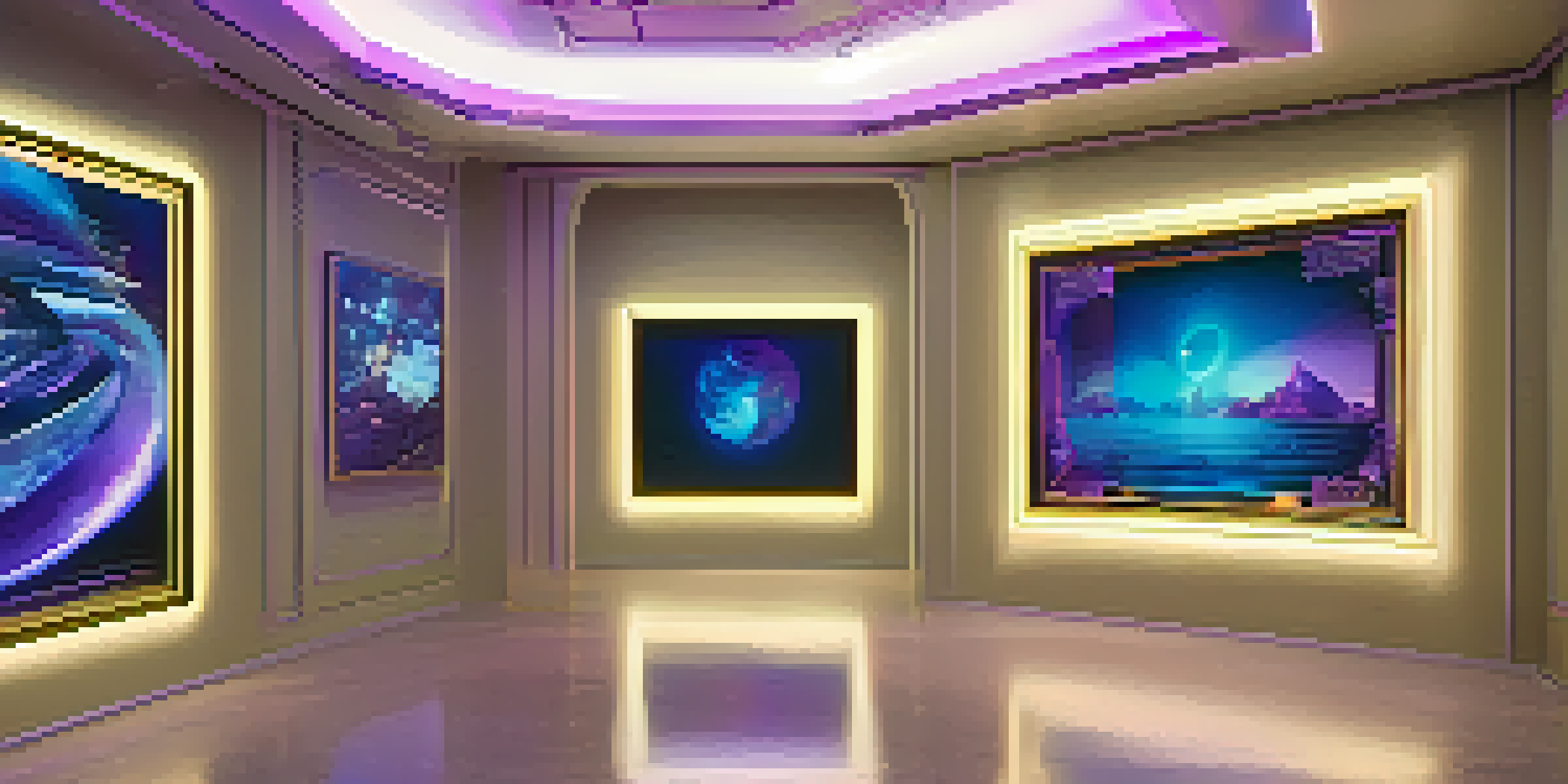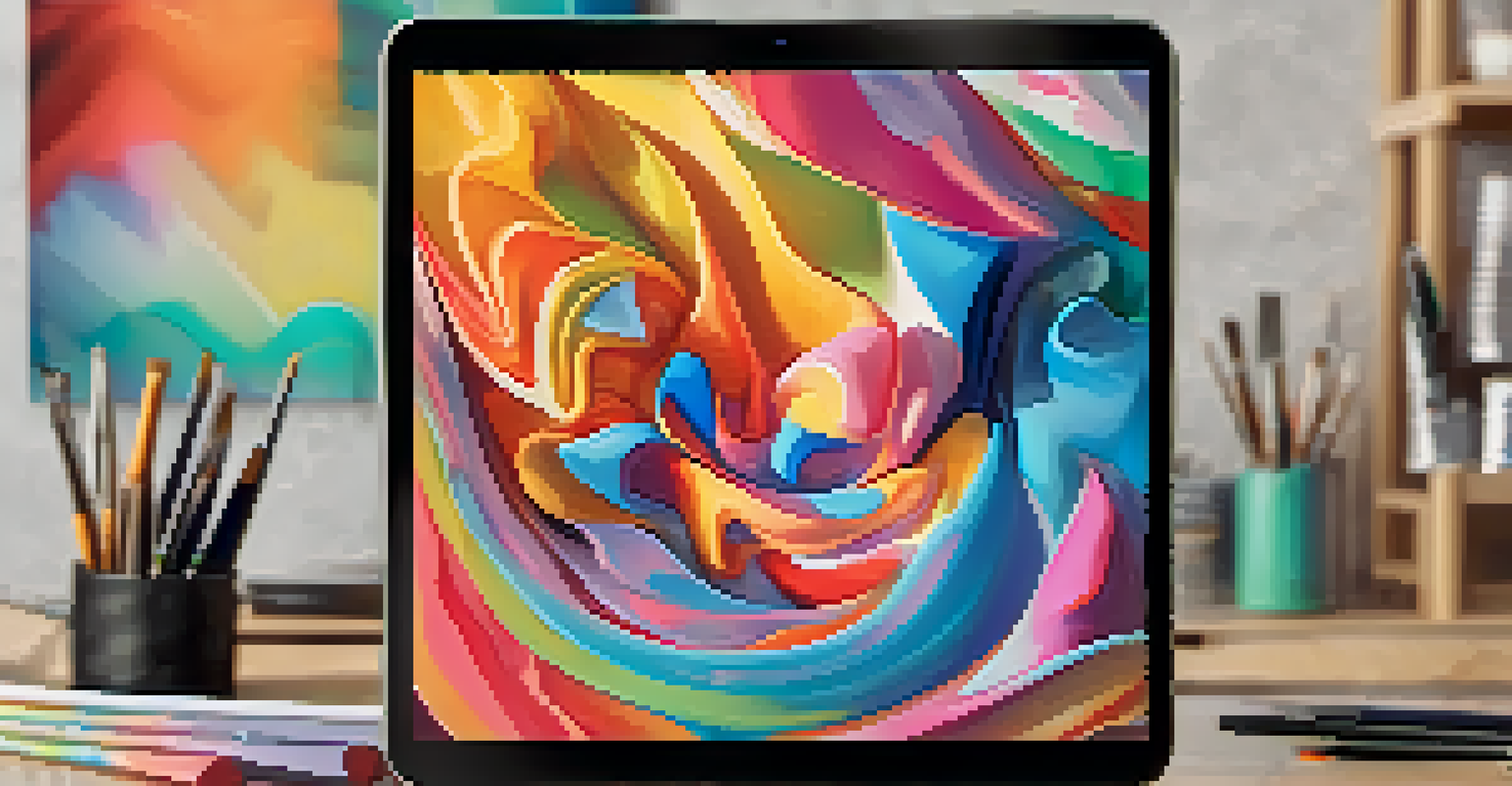The Role of NFTs in Digital Art Preservation Strategies

Understanding NFTs and Their Significance in Art
Non-fungible tokens, or NFTs, are unique digital assets verified using blockchain technology. Unlike cryptocurrencies, which are interchangeable, NFTs represent ownership of a specific item, making them especially valuable in the art world. This uniqueness is crucial for digital art, where copies can be made easily but authenticity is harder to establish.
Art is not freedom from discipline, but disciplined freedom.
By providing a way to verify ownership and provenance, NFTs create a digital certificate for artists and collectors alike. Imagine buying a rare painting; the NFT acts as the digital equivalent of this certificate, ensuring that the piece is one-of-a-kind. This innovation opens up new possibilities for artists to sell and share their work while maintaining its value.
The growing popularity of NFTs has prompted many artists to explore this medium, effectively merging traditional art concepts with cutting-edge technology. As more creators embrace NFTs, their role in preserving digital art becomes increasingly significant, highlighting the need for a deeper understanding of this intersection.
The Challenges of Digital Art Preservation
Digital art faces unique challenges compared to traditional artwork. One major issue is the ephemeral nature of digital files; they can be easily lost or corrupted. Additionally, the rapid advancement of technology means that formats and platforms can become obsolete, risking the longevity of digital artworks.

Without proper preservation strategies, digital art could vanish or become inaccessible within a few years. Think of it like trying to watch a VHS tape without a working VCR—it becomes a relic of the past. This reality necessitates innovative solutions to ensure that digital art remains preserved and accessible for future generations.
NFTs Verify Digital Art Ownership
NFTs provide verifiable proof of ownership, allowing artists to maintain control and receive compensation for their work.
Moreover, there’s the question of copyright and ownership in the digital realm. Artists often struggle with unauthorized reproductions, raising concerns about their rights and the financial implications of losing control over their work. NFTs provide potential solutions to these issues, but they also bring new complexities that need to be addressed.
How NFTs Enhance Digital Art Ownership
NFTs allow artists to maintain ownership over their digital creations in ways that were previously impossible. By minting their artwork as NFTs, creators can ensure that they receive recognition and financial compensation each time their work is sold or resold. This creates a more sustainable financial model for artists, fostering a healthier creative ecosystem.
The future of art is not just about what you see, but what you experience.
For collectors, owning an NFT means having verifiable proof of ownership, which can be displayed in digital galleries or sold on various platforms. This ownership is akin to possessing a limited edition print of a famous painting, where value is tied to authenticity and scarcity. With NFTs, collectors can easily showcase their digital assets and engage with a community of like-minded enthusiasts.
This new model not only empowers artists and collectors but also encourages investment in digital art. As NFTs continue to gain traction, the perception of digital art as a legitimate and valuable medium is solidifying, leading to a more robust market for creators.
Preserving Digital Art through Blockchain Technology
Blockchain technology is the backbone of NFTs, providing a decentralized and secure method for tracking ownership and provenance. This feature is crucial for preserving digital art, as it ensures that the history of an artwork is transparent and immutable. Each transaction is recorded on the blockchain, making it easy to trace the journey of an artwork from artist to collector.
The decentralized nature of blockchain also means that digital artworks are less susceptible to loss or manipulation. Unlike traditional storage methods that can fail, blockchain offers a reliable solution for safeguarding digital art. Imagine having a digital vault that securely stores your valuable assets, accessible only to you and verifiable by anyone.
Blockchain Ensures Art Preservation
Blockchain technology secures digital art ownership and provenance, protecting it from loss and manipulation.
As more artists and collectors recognize the importance of blockchain for preservation, we can expect to see enhanced security measures and innovative applications. This technology not only protects art but also fosters trust within the community, ensuring that digital art can thrive in a rapidly evolving landscape.
The Role of Marketplaces in NFT Art Preservation
NFT marketplaces play a pivotal role in the ecosystem of digital art preservation. These platforms facilitate the buying, selling, and trading of NFTs, providing a space for artists and collectors to connect. By offering a user-friendly experience, these marketplaces help demystify the process of owning digital art, making it more accessible to a broader audience.
Additionally, many marketplaces are now implementing features that encourage the preservation of digital art. For instance, some platforms provide educational resources on how to create and maintain NFTs, ensuring that artists are well-informed about best practices. This proactive approach helps safeguard the future of digital art.
Moreover, as competition among marketplaces grows, they are increasingly focused on creating features that enhance the preservation of art. This includes partnerships with galleries, exhibitions, and even initiatives to support artists in their creative journeys. Such efforts highlight the importance of community and collaboration in the digital art space.
Future Trends in NFTs and Digital Art Preservation
As we look ahead, the relationship between NFTs and digital art preservation is likely to evolve significantly. One emerging trend is the integration of augmented reality (AR) and virtual reality (VR) with NFTs, creating immersive experiences for collectors. Imagine walking through a digital gallery where you can interact with the artwork in real-time; this could revolutionize how we engage with digital art.
Another trend is the growing focus on sustainability in the NFT space. With concerns about the environmental impact of blockchain technology, artists and platforms are exploring eco-friendly solutions. This shift will not only preserve digital art but also align with the values of a more environmentally conscious audience.
Marketplaces Support Digital Art
NFT marketplaces facilitate connections between artists and collectors while promoting best practices for digital art preservation.
Finally, as the legal frameworks surrounding NFTs continue to develop, we can expect clearer guidelines on copyright and ownership. This clarity will help artists protect their work and foster trust within the community, ensuring that digital art can flourish in a secure environment.
Conclusion: The Promise of NFTs for Digital Art Preservation
In conclusion, NFTs are proving to be a game-changer in the realm of digital art preservation. By providing verifiable ownership and leveraging blockchain technology, they offer solutions to many challenges faced by digital artists. This innovation not only empowers creators but also enriches the experience for collectors and enthusiasts alike.
As we continue to explore the potential of NFTs, it's essential to remain aware of the challenges and responsibilities that come with this technology. Artists must navigate the complexities of copyright, while collectors should be mindful of the implications of ownership in the digital age. Together, we can create a more sustainable future for digital art.

Ultimately, the promise of NFTs lies in their ability to bridge the gap between technology and creativity. By embracing these advancements, we open up new avenues for artistic expression and ensure that digital art will be preserved for generations to come.